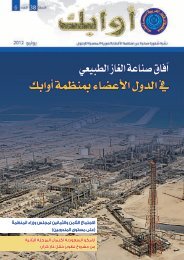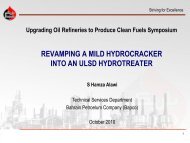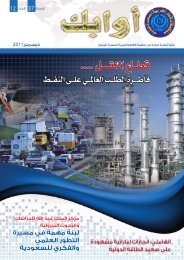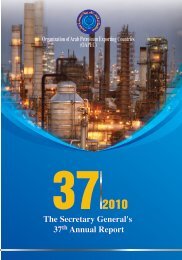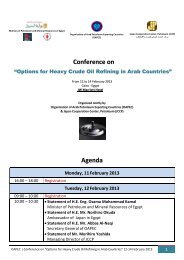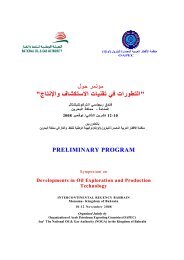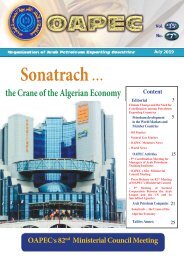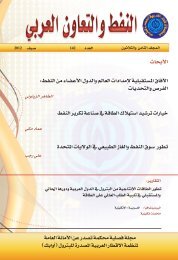chapter two - OAPEC
chapter two - OAPEC
chapter two - OAPEC
Create successful ePaper yourself
Turn your PDF publications into a flip-book with our unique Google optimized e-Paper software.
The second group comprises four countries with a per capita GDP less<br />
than $2000. They were Sudan ($1599), Yemen ($1181), Djibouti ($1131),<br />
and Mauritania ($1128).<br />
2- Population: The average population growth in the Arab countries<br />
during 2005-2009 was 2.36%, when the population of the Arab<br />
countries increased from 312 million in 2005 to about 342 million in<br />
2009.<br />
3- Prices: Several Arab countries in the recent years have resorted to<br />
raising the prices of oil products on the local market in order to reflect<br />
the adaptation of abolition of prices subsidies policies, and in response<br />
to the increase in international crude oil prices.<br />
1-2 Energy Consumption by Source<br />
The global financial crisis supported the downward trend in energy<br />
consumption growth in the Arab countries. In 2009, Total energy<br />
consumption in the Arab countries amounted to 10.6 million barrels of oil<br />
equivalent per day (boe/d) compared to 10.2 million (boe/d) in 2008, an<br />
increase of 3.2%.<br />
Energy consumption in the Arab countries is increasingly dependent<br />
on petroleum (oil and natural gas), which account for 98.2% of total energy<br />
consumption in Arab countries in 2009. Oil continues to be the main source<br />
of energy consumption in the Arab countries, despite the increasing use of<br />
natural gas. Oil meets over half the Arab countries energy requirements,<br />
accounting for 52.8% in 2009, compared with 45.4% for natural gas, 1.3%<br />
for hydroelectricity, and 0.4% for coal.<br />
Among non-<strong>OAPEC</strong> Arab countries oil plays an essential role in the<br />
energy mix, accounting for 78.6% of their energy needs, compared with<br />
50.3% in <strong>OAPEC</strong> member countries. On the other hand, natural gas plays a<br />
bigger role in <strong>OAPEC</strong> member countries, accounting for 48.3% of their<br />
total energy consumption, compared with 16.6% in other Arab countries, as<br />
shown in Figure (1-16) and Table (1-18).<br />
The disparity in energy consumption may be attributed to the differing<br />
availability of hydrocarbon resources in the Arab countries.<br />
<strong>OAPEC</strong> members accounted for 90.9% of total energy consumption in<br />
the Arab countries in 2009 and other Arab countries for 9.1%.The growth<br />
rate of energy consumption in <strong>OAPEC</strong> members was 3.1%, close to that of<br />
other Arab countries (2.5%).



